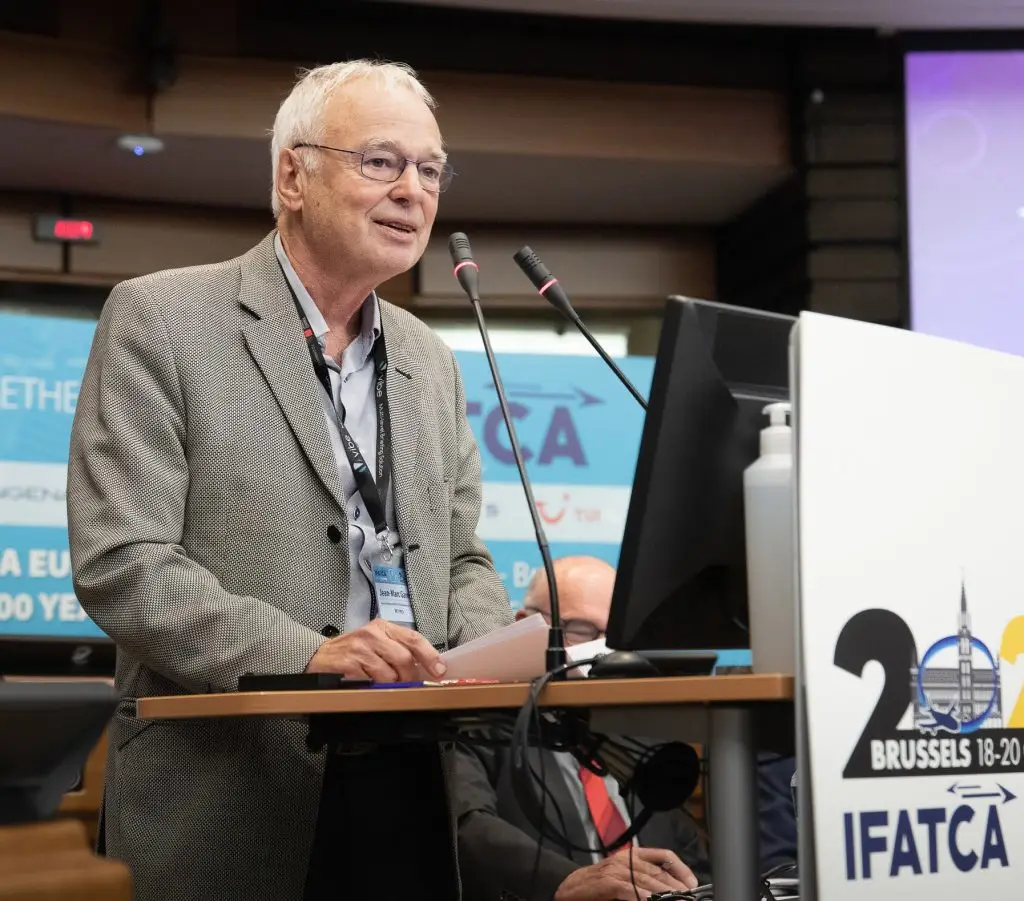
by Jean-Marc Garot
former Director of the EUROCONTROL Experimental Centre in BrétignyThis is a summary of a presentation made in Brussels in October 2022 on the occasion of IFATCA’s 100 years of ATC celebration
During the first 50 years, from what I read in the books, there have been a lot of changes from procedural ATC to radar with horizontal displays with “shrimp boats” and, later, vertical displays with primitive computers.
During the second half of these 100 years, I have been an actor, mainly in Europe and a little in the USA. Therefore, my knowledge of the rest of the world is limited. Despite the successive plans: in the USA, the National Airspace System (NAS) plan, the famous Brown Book, Free Flight, Nextgen and in Europe, EATCHIP, EATMS, ATM+, SESAR, all in all, there have not been that many significant changes, unless one considers moving from black and white round displays to colour rectangular ones to be one. For example, in the US NAS of 1980, the full data link coverage over the USA was planned for … 1995. NEXTGEN is still … “planning” it, and in Europe, so far, the ADS-C is a piecemeal surrogate. Mass mobile phone communications are up to 5 G, but ATC voice communication is half-G!?
I do not feel bold enough to forecast the next 100 years. Even ICAO, in its decarbonisation roadmap, this Long-Term Aspiration Goal (LTAG, what an acronym!) limits itself to 2070, and I will do the same. I do not foresee any revolution or a change of paradigm. I do not see how what has not been implemented in the past 50 years could be in the 50 years to come, not only full automation for what it means but automatic conflict detection and resolution and time-based arrival sequencing.
Pilots will still be physically in the cockpits and air traffic controllers remotely in the facilities, including remote towers. Even with more tools available in the cockpit, rather than focusing only on human errors, systematic in-flight recordings will make the role of pilots to recover from incidents and prevent accidents even more obvious. Even with more tools available, ATC will always require human beings to take the right decisions at the right time, even, like any human being, they could make mistakes.
Therefore, I am going to address not only the three classical components of Air Traffic Management (ATM): Air Space Management (ASM); Air Traffic Flow Management (ATFM) and Air Traffic Control (ATC) but a fourth one, which is often overlooked, People Management.
Air Space Management (ASM)
Even in some non-conflict areas, like parts of Europe, because of airspace required by air defence for the training of crews and testing new aircraft, civilian traffic will still be constrained.
Even further, autonomous military drones may require significant airspace and, because there are so many conflict zones around the World, many airspaces will remain off-limits. Therefore, there will be an even greater need for an improved ASM.
Rules of thumb will be increasingly complemented by optimisation techniques, but they should be at a regional level. Indeed, it does not make sense to have inconsistent sectorisations in two adjacent air traffic control centres. They should be more flexible to allow for dynamic airspace allocation between adjacent air traffic control centres, compared to the rigid European Political Airspace Block – PAB rather than FAB!
Air Traffic Flow Management (ATFM)
This is the area where improvements will need to speed up. The US setup is the most advanced with its Command-and-Control Centre; The European Network Manager will eventually get the same power as the cornerstone of the European ATC defragmentation, as the cornerstone of the Single European Sky (SES). Other Regional Network Managers will be developed.
It will be recognised that, until an aircraft is aloft, one does not know when it will take off or, even if it will take off at all, and therefore that ATC is not deterministic. ATFM will be more and more dynamic with probability-based modelling tools allowing for some yield management. One can even think of deep learning processes since ATFM forecast is based upon past traffic. With better use of the capacity, one can expect to reduce delays, in-the-air fuel consumption, and C02 emissions. By large, this will provide this reduction compared to this false idea of even more direct trajectories and the very minor reduction of energy consumption for the infrastructure, like solar cells to power and isolated VOR! But, first, the airports will have to adjust their slots to the actual capacity, and second, one will have to study the trade-off between waiting at the departure airports and the likelihood of holding patterns or longer trajectories, consuming more fuel at the arrival. With airport constraints and concern with CO2 emissions, Urban Airborne Mobility (UAM) is unlikely to be more than a false idea, even if some money is wasted on many projects.
Air Traffic Control
In the 1990s, ATC research was carried out by US and EU national centres, plus the Eurocontrol Experimental Centre, in a cooperative mode. It led to the de-facto harmonisation of Human-Computer Interfaces since the manufacturers provided the same look and feel of their ATC systems. Examples are the eight Balkans countries (Croatia, Slovenia, Serbia, Montenegro, Albania, Bosnia Herzegovina, Kosovo, Macedonia) I had the chance to visit, whatever the system provider: Indra, Thales, Selex or even Lockheed-Martin! One can expect to see the end of specific national developments, which is still currently the case in some countries Europe.
As far as more “automated tools” are concerned, I will repeat that, once aloft, an aircraft trajectory is almost deterministic. According to the Lorenz principle, with slight modifications of initial conditions leading to different results, ATC is not. As an illustration, we can look at a pool table.
Therefore, all the ATC 4D trajectories projects are prone to failure, and one should forget all the buzzwords of digitalisation or, even worse, Artificial Intelligence which is blurring the actual issue of what tools can or should still be developed. Indeed, there is still room for the larger deployment of automated “housekeeping tasks” and “what if” functions like Medium Term Conflict Detection but not automated Medium-Term Conflict Detection and Resolution where the controller is no longer in charge. In the same line, I do not believe in time-based arrival sequencing. At best, there will be the full deployment of the Eurocontrol Experimental Centre’s smart idea of replacing the trombone arrivals with circles with Point Merge. For critical tasks, the communication will stay vocal.
The Controller Pilot Data Link Communication (CPDLC) is a false idea if it is only typing the clearance by the controller, reading it by the pilot who enters it in the Flight Management System (FMS) since it increases the risk of errors unless there is an integrated process with MTCD on the ground and “menus” in the cockpit. So far, this has not been implemented. At least, to close the safety loop, with the MODE-S and the ADS-C, it is possible to downlink from the FMS the information introduced by the pilot.
Hopefully, with the worldwide satellite internet, it would be possible to get a high-quality “voice on IP”, as proposed by the SESAR JU VOICE project that can be seen here.
All in all, it is more than “keeping the controller in the loop”. An air traffic controller’s job is an intellectual craft; they use tools only if they help them. Whether one likes it or not, the controller will stay at the centre of ATC, leading to the last point.
People Management
ATC is a double virtual job. First, there are the only workers in air transport who are not “seen” by the passengers, who hear of them only when there are delays and strikes. Second, their work, as an intellectual craft, is in their mind. One may wonder why thousands of reports from Human Factors specialists have not been acted on. When there are visitors in ops rooms, it happens, when spectators are watching movies or documentaries, they have no clue whatsoever of what is happening…especially when asked, controllers can answer questions while keeping doing their job.
But are air traffic controllers willing to explain their job and not keep it mysterious to keep their power and, even in a few countries, get comfortable working conditions and wages? As a result, in some countries, at best, air traffic controllers got financial recognition but little social recognition. Even if the traffic is back, the 2019/2020 COVID crisis has shown how the financial scheme of ATC with corporatisation or even privatisation is fragile, an understatement.
A ripple effect can be forecasted for 2023 on the User Charges and, even later on, as explained by Matthias Finger, since the traffic increase in Europe will longer be the same, I think that the ATC, which are still public services should stay as such. Those which were corporatized or even privatised should go back to being a public service and, as in the USA, with a disconnect between the budget as part of the national budget and user charges by the passengers. In Europe, ATC should become a European public service.
As public servants in charge of safety, air traffic controllers may get public recognition. Are they willing to deserve it?





